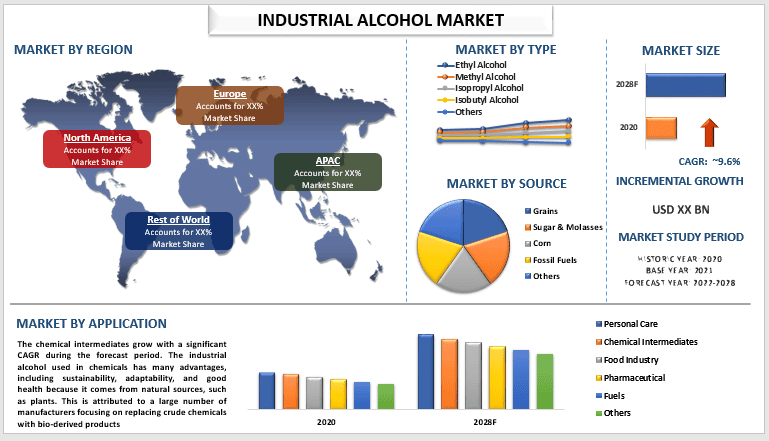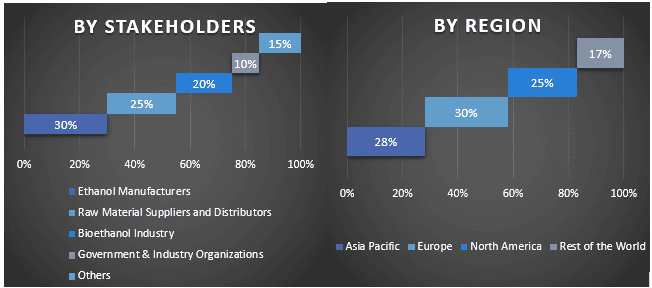- Strona główna
- O nas
- Branża
- Usługi
- Czytanie
- Kontakt
Rynek alkoholu przemysłowego: aktualna analiza i prognoza (2022-2028)
Nacisk na rodzaj (alkohol etylowy, alkohol metylowy, alkohol izopropylowy, alkohol izobutylowy i inne); źródło (zboża, cukier i melasa, kukurydza, paliwa kopalne i inne); zastosowanie (higiena osobista, półprodukty chemiczne, przemysł spożywczy, farmaceutyka, paliwa i inne); oraz region/kraj

Oczekuje się, że globalny rynek alkoholu przemysłowego będzie rósł w znaczącym tempie około 9,6% w okresie prognozy 2022-2028. Alkohol przemysłowy oznacza alkohol, który jest produkowany wyłącznie do celów przemysłowych (47-68) i nie nadaje się do spożycia przez ludzi. Fermentacja cukrów pozyskiwanych z pszenicy, kukurydzy, buraków cukrowych, trzciny cukrowej i melasy prowadzi do produkcji biopaliw. W związku z tym rosnące zużycie i popyt na etanol jako biopaliwo napędzają wzrost rynku. W 2021 roku, po raz drugi od rozpoczęcia monitorowania, Stany Zjednoczone wyeksportowały więcej ropy niż zaimportowały. Średnie zużycie ropy naftowej w USA wyniosło 19,8 miliona baryłek dziennie. W 2021 roku w USA działało 197 rafinerii etanolu i 75 zakładów produkcji biodiesla, według U.S. Energy Information Administration.
Oczekuje się również, że rynek będzie rósł w wyniku proaktywnych działań rządów, rosnącego zużycia metanolu w przemyśle chemicznym wraz z gwałtownym wzrostem liczby zakładów produkcyjnych. Oczekuje się, że główne sojusze firm mające na celu redukcję emisji gazów cieplarnianych i minimalizację zależności przemysłu energetycznego od importowanych paliw kopalnych pobudzą wzrost rynku. Na przykład w lipcu 2020 roku Green Plains rozbudowała swój zakład w swojej spółce zależnej, Green Plain Wood River LLC, w celu produkcji alkoholu klasy FCC i USP spełniającego specyfikacje FDA w celu zmniejszenia emisji gazów cieplarnianych.
Cargill Incorporated; MGP Ingredients, Inc., Green Plains Inc, Cristalco, GREENFIELD GLOBAL INC., Flint Hills Resources, Merck KGaA, The Andersons Inc, BASF SE, Raízen to jedni z kluczowych graczy na rynku. Gracze ci podjęli kilka fuzji i przejęć wraz z partnerstwami, aby ułatwić klientom korzystanie z zaawansowanych technologicznie i innowacyjnych produktów/technologii.
Informacje przedstawione w raporcie
„Wśród typów, alkohol etylowy miał znaczący udział w rynku w 2020 r.”
Na podstawie typu rynek jest podzielony na alkohol etylowy, alkohol metylowy, alkohol izopropylowy, alkohol izobutylowy i inne. Alkohol etylowy miał znaczący udział w rynku w 2020 r. Alkohol etylowy zmniejsza emisję spalin, poprawia jakość powietrza, zwiększa niezależność energetyczną, obniża ceny paliw dla konsumentów i zapewnia rynki o wartości dodanej dla amerykańskich rolników. Zatem wyżej wymienione czynniki napędzają wzrost rynku.
„Wśród zastosowań półprodukty chemiczne rosną ze znaczącym CAGR w okresie prognozy”
Na podstawie zastosowania rynek alkoholu przemysłowego został podzielony na: produkty higieny osobistej, półprodukty chemiczne, przemysł spożywczy, farmaceutyczny, paliwa i inne. Półprodukty chemiczne rosną ze znaczącym CAGR w okresie prognozy. Alkohol przemysłowy stosowany w chemikaliach ma wiele zalet, w tym zrównoważony rozwój, zdolność adaptacji i dobre zdrowie, ponieważ pochodzi z naturalnych źródeł, takich jak rośliny. Wynika to z faktu, że wielu producentów koncentruje się na zastępowaniu surowych chemikaliów produktami pochodzenia biologicznego.
„Ameryka Północna będzie miała znaczący udział w rynku”
W 2020 roku Ameryka Północna miała znaczący udział w globalnym rynku alkoholu przemysłowego. Przemysł rozwija się szybko ze względu na rosnące wykorzystanie etanolu jako paliwa do zastosowań transportowych. Agencja Ochrony Środowiska (EPA) ma szereg programów, które pomagają wspierać produkty przyjazne dla środowiska i zrównoważone, wytwarzane z wykorzystaniem odnawialnych źródeł energii. Popyt na paliwo etanolowe znacznie wzrasta wraz z kupowaniem samochodów przez coraz większą liczbę osób, co obniża koszty ogólne. Zakłady produkujące etanol muszą przestrzegać wymogów Ustawy o modernizacji bezpieczeństwa żywności (FSMA), aby spełniać przepisy U.S. Food & Drug Administration (FSMA). Te środki zapobiegawcze zapewniają klientom na całym świecie, że amerykańskie produkty uboczne etanolu z bezpiecznymi składnikami paszowymi są produkowane. Przewiduje się, że rynek alkoholu przemysłowego w Ameryce Północnej znacznie wzrośnie w wyniku tych przyczyn.
Powody, dla których warto kupić ten raport:
- Badanie obejmuje analizę wielkości rynku i prognoz, zatwierdzoną przez uwierzytelnionych kluczowych ekspertów branżowych.
- Raport przedstawia szybki przegląd ogólnej kondycji branży na pierwszy rzut oka.
- Raport obejmuje dogłębną analizę wybitnych podmiotów z branży, z głównym naciskiem na kluczowe dane finansowe, portfolio produktów, strategie ekspansji i najnowsze osiągnięcia.
- Szczegółowe badanie czynników napędzających, ograniczeń, kluczowych trendów i możliwości występujących w branży.
- Badanie kompleksowo obejmuje rynek w różnych segmentach.
- Dogłębna analiza branży na poziomie regionalnym.
Opcje dostosowywania:
Globalny rynek alkoholu przemysłowego można dodatkowo dostosować zgodnie z wymaganiami lub dowolnym innym segmentem rynku. Poza tym UMI rozumie, że możesz mieć własne potrzeby biznesowe, dlatego zachęcamy do kontaktu z nami, aby otrzymać raport, który w pełni odpowiada Twoim wymaganiom.
Spis treści
Metodologia badań rynku alkoholu przemysłowego (2022-2028)
Analiza historycznego rynku, szacowanie obecnego rynku i prognozowanie przyszłego rynku globalnego rynku alkoholu przemysłowego to trzy główne kroki podjęte w celu stworzenia i analizy adopcji alkoholi przemysłowych w głównych regionach na świecie. Przeprowadzono wyczerpujące badania wtórne w celu zebrania danych historycznych o rynku i oszacowania obecnej wielkości rynku. Po drugie, w celu zweryfikowania tych spostrzeżeń wzięto pod uwagę liczne ustalenia i założenia. Ponadto przeprowadzono również wyczerpujące wywiady pierwotne z ekspertami branżowymi w całym łańcuchu wartości globalnego rynku alkoholu przemysłowego. Po założeniu i zatwierdzeniu danych rynkowych poprzez wywiady pierwotne, zastosowaliśmy podejście odgórne/oddolne do prognozowania całkowitej wielkości rynku. Następnie zastosowano metody podziału rynku i triangulacji danych w celu oszacowania i analizy wielkości rynku segmentów i podsegmentów branży, której dotyczy. Szczegółowa metodologia jest wyjaśniona poniżej:
Analiza historycznej wielkości rynku
Krok 1: Dogłębne badanie źródeł wtórnych:
Przeprowadzono szczegółowe badanie wtórne w celu uzyskania historycznej wielkości rynku alkoholu przemysłowego za pośrednictwem wewnętrznych źródeł firmy, takich jak raporty roczne i sprawozdania finansowe, prezentacje wyników, komunikaty prasowe itp., oraz źródeł zewnętrznych, w tym czasopisma, wiadomości i artykuły, publikacje rządowe, publikacje konkurencji, raporty sektorowe, bazy danych stron trzecich i inne wiarygodne publikacje.
Krok 2: Segmentacja rynku:
Po uzyskaniu historycznej wielkości rynku alkoholu przemysłowego przeprowadziliśmy szczegółową analizę wtórną w celu zebrania historycznych danych rynkowych i udziału w różnych segmentach i podsegmentach dla głównych regionów. Główne segmenty zawarte w raporcie to rodzaj, źródło i zastosowanie. Ponadto przeprowadzono analizy na poziomie krajowym w celu oceny ogólnego przyjęcia modeli testowania w danym regionie.
Krok 3: Analiza czynnikowa:
Po uzyskaniu historycznej wielkości rynku różnych segmentów i podsegmentów przeprowadziliśmy szczegółową analizę czynnikową w celu oszacowania obecnej wielkości rynku alkoholu przemysłowego. Ponadto przeprowadziliśmy analizę czynnikową przy użyciu zmiennych zależnych i niezależnych, takich jak różne rodzaje, źródła i zastosowania alkoholi przemysłowych. Przeprowadzono dokładną analizę scenariuszy popytu i podaży, biorąc pod uwagę najważniejsze partnerstwa, fuzje i przejęcia, ekspansję biznesową i wprowadzenie produktów na rynek alkoholu przemysłowego na całym świecie.
Szacunek i prognoza obecnej wielkości rynku
Określanie obecnej wielkości rynku: Na podstawie praktycznych wniosków z powyższych 3 kroków doszliśmy do obecnej wielkości rynku, kluczowych graczy na globalnym rynku alkoholu przemysłowego i udziałów w rynku poszczególnych segmentów. Wszystkie wymagane udziały procentowe i podziały rynku zostały określone przy użyciu wspomnianego powyżej podejścia wtórnego i zweryfikowane poprzez wywiady pierwotne.
Szacowanie i prognozowanie: Do szacowania i prognozowania rynku przypisano wagi różnym czynnikom, w tym czynnikom napędzającym i trendom, ograniczeniom i możliwościom dostępnym dla zainteresowanych stron. Po przeanalizowaniu tych czynników zastosowano odpowiednie techniki prognozowania, tj. podejście odgórne/oddolne, aby dojść do prognozy rynkowej na rok 2028 dla różnych segmentów i podsegmentów na głównych rynkach na świecie. Metodologia badań przyjęta w celu oszacowania wielkości rynku obejmuje:
- Wielkość rynku branży pod względem przychodów (USD) i wskaźnik adopcji rynku alkoholu przemysłowego na głównych rynkach krajowych
- Wszystkie udziały procentowe, podziały i rozbicia segmentów i podsegmentów rynku
- Kluczowi gracze na globalnym rynku alkoholu przemysłowego pod względem oferowanych produktów. Ponadto strategie rozwoju przyjęte przez tych graczy, aby konkurować na szybko rozwijającym się rynku
Walidacja wielkości i udziału w rynku
Badania pierwotne: Przeprowadzono dogłębne wywiady z kluczowymi liderami opinii (KOL), w tym z kadrą kierowniczą najwyższego szczebla (CXO/VP, szef sprzedaży, szef marketingu, szef operacyjny, szef regionalny, szef krajowy itp.) w głównych regionach. Następnie podsumowano wyniki badań pierwotnych i przeprowadzono analizę statystyczną w celu udowodnienia postawionej hipotezy. Dane wejściowe z badań pierwotnych zostały skonsolidowane z ustaleniami wtórnymi, przekształcając w ten sposób informacje w praktyczne spostrzeżenia.
Podział uczestników badań pierwotnych w różnych regionach

Inżynieria rynku
Zastosowano technikę triangulacji danych, aby ukończyć ogólne oszacowanie rynku i dojść do precyzyjnych danych statystycznych dla każdego segmentu i podsegmentu globalnego rynku alkoholu przemysłowego. Dane podzielono na kilka segmentów i podsegmentów po przestudiowaniu różnych parametrów i trendów w obszarach typu, źródła i zastosowania na globalnym rynku alkoholu przemysłowego.
Główny cel badania globalnego rynku alkoholu przemysłowego
W badaniu wskazano obecne i przyszłe trendy rynkowe globalnego rynku alkoholu przemysłowego. Inwestorzy mogą uzyskać strategiczne spostrzeżenia, na których mogą oprzeć swoją decyzję o inwestycjach na podstawie analizy jakościowej i ilościowej przeprowadzonej w badaniu. Obecne i przyszłe trendy rynkowe zdeterminowały ogólną atrakcyjność rynku na poziomie regionalnym, zapewniając uczestnikom przemysłu platformę do wykorzystania niewykorzystanego rynku, aby skorzystać z przewagi pioniera. Inne cele ilościowe badań obejmują:
- Analiza obecnej i prognozowanej wielkości rynku alkoholu przemysłowego pod względem wartości (USD). Ponadto analiza obecnej i prognozowanej wielkości rynku różnych segmentów i podsegmentów
- Segmenty w badaniu obejmują obszary typu, źródła i zastosowania.
- Definicja i analiza ram regulacyjnych dla alkoholu przemysłowego
- Analiza łańcucha wartości związanego z obecnością różnych pośredników, wraz z analizą zachowań klientów i konkurentów w branży.
- Analiza obecnej i prognozowanej wielkości rynku alkoholu przemysłowego dla głównego regionu.
- Główne kraje regionów badane w raporcie to Azja i Pacyfik, Europa, Ameryka Północna i reszta świata.
- Profile firm z rynku alkoholu przemysłowego i strategie rozwoju przyjęte przez uczestników rynku, aby utrzymać się na szybko rozwijającym się rynku
- Dogłębna analiza regionalna branży
Powiązane Raporty
Klienci, którzy kupili ten przedmiot, kupili również










